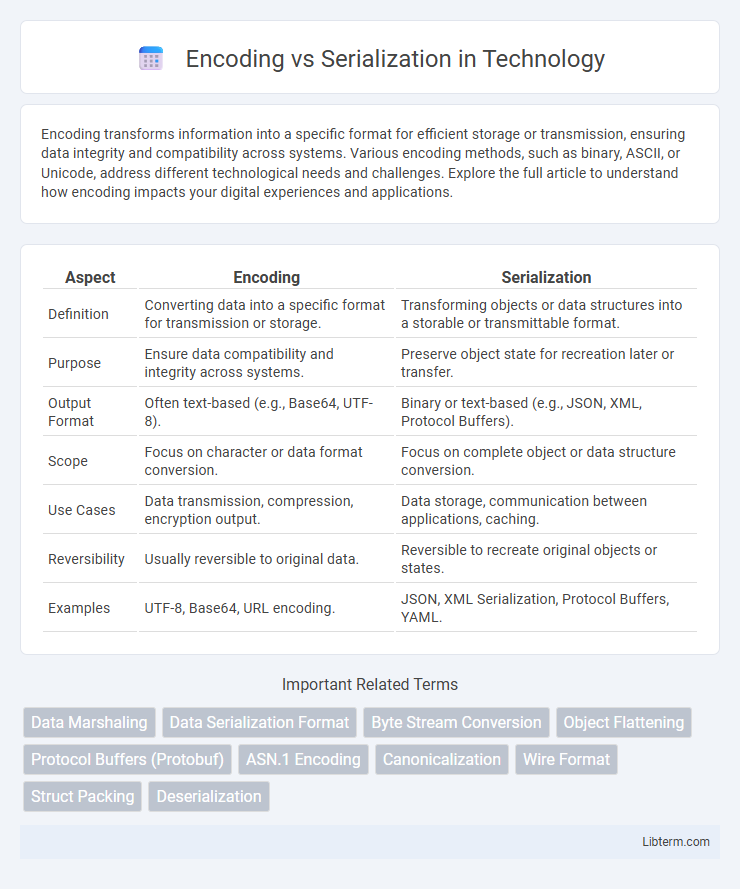Encoding transforms information into a specific format for efficient storage or transmission, ensuring data integrity and compatibility across systems. Various encoding methods, such as binary, ASCII, or Unicode, address different technological needs and challenges. Explore the full article to understand how encoding impacts your digital experiences and applications.
Table of Comparison
| Aspect | Encoding | Serialization |
|---|---|---|
| Definition | Converting data into a specific format for transmission or storage. | Transforming objects or data structures into a storable or transmittable format. |
| Purpose | Ensure data compatibility and integrity across systems. | Preserve object state for recreation later or transfer. |
| Output Format | Often text-based (e.g., Base64, UTF-8). | Binary or text-based (e.g., JSON, XML, Protocol Buffers). |
| Scope | Focus on character or data format conversion. | Focus on complete object or data structure conversion. |
| Use Cases | Data transmission, compression, encryption output. | Data storage, communication between applications, caching. |
| Reversibility | Usually reversible to original data. | Reversible to recreate original objects or states. |
| Examples | UTF-8, Base64, URL encoding. | JSON, XML Serialization, Protocol Buffers, YAML. |
Introduction to Encoding and Serialization
Encoding transforms data into a specific format for efficient storage or transmission, often converting characters into byte streams using standards like UTF-8 or ASCII. Serialization converts complex objects or data structures into a format that can be easily stored or transmitted and later reconstructed, with common formats including JSON, XML, and Protocol Buffers. Both processes are essential in data communication, ensuring information integrity and compatibility across different systems and platforms.
Defining Encoding
Encoding is the process of converting data from one format into another, typically to ensure compatibility or efficient transmission between systems. It transforms information into a standardized format like UTF-8 for text or base64 for binary data, enabling consistent interpretation across various software and hardware. Unlike serialization, encoding specifically focuses on representing data in a specific format rather than structuring complex objects or data models.
Defining Serialization
Serialization is the process of converting complex data structures or objects into a format that can be easily stored or transmitted, typically as a byte stream. This transformation enables data exchange between different systems, persistence to files, or communication over networks. Unlike encoding, which translates data into a different format or representation while preserving its meaning, serialization focuses on capturing the complete state of an object for reconstruction later.
Key Differences Between Encoding and Serialization
Encoding transforms data into a specific format for efficient transmission or storage, often converting it into binary or text formats like Base64 or ASCII. Serialization converts complex objects or data structures into a format that can be easily stored or transmitted and later reconstructed, typically using formats such as JSON, XML, or Protocol Buffers. Key differences include their primary purpose--encoding focuses on format representation and compatibility, while serialization focuses on preserving object state and structure for data exchange or persistence.
Common Encoding Techniques
Common encoding techniques such as Base64, UTF-8, and ASCII convert data into specific formats suitable for storage or transmission, ensuring compatibility across different systems. Base64 encodes binary data into ASCII characters, making it ideal for email and web use, while UTF-8 encodes Unicode characters for text representation in web pages and applications. ASCII provides a simple encoding standard for representing English characters, crucial for legacy systems and basic text processing.
Popular Serialization Formats
Popular serialization formats include JSON, XML, Protocol Buffers, and Avro, each designed for efficient data interchange and storage. JSON offers human-readable text, widely used in web APIs, while Protocol Buffers provide compact binary encoding with schema enforcement for faster processing. XML supports complex schema definitions, making it suitable for enterprise applications, and Avro integrates well with big data ecosystems like Apache Hadoop for schema evolution and interoperability.
Use Cases of Encoding
Encoding converts data into a specific format for efficient storage or transmission, such as Base64 encoding for embedding images in HTML or URL encoding for safely transmitting data in web addresses. Encoding is essential for ensuring data integrity across different systems by converting characters into compatible formats, like UTF-8 for international text representation. Common use cases include preparing data for network protocols, email transfer, and secure storage in databases.
Use Cases of Serialization
Serialization is essential for use cases such as saving the state of an object to a file or database, enabling long-term storage and later retrieval. It facilitates communication between distributed systems by converting complex data structures into formats suitable for transmission over networks, such as JSON or XML. Serialization also plays a crucial role in caching, allowing applications to quickly store and restore objects to improve performance.
Encoding vs Serialization: Performance Comparison
Encoding transforms data into a specific format for storage or transmission, often involving character set conversions, while serialization converts complex objects into a byte stream for persistence or communication. Performance-wise, encoding generally requires less computational overhead for simple data transformations, whereas serialization can be more resource-intensive due to object graph traversal and metadata processing. Efficient implementation of both depends on the use case, with encoding excelling in speed for text processing and serialization being optimized for complex data structures exchange.
Choosing the Right Approach: Encoding or Serialization
Choosing between encoding and serialization depends on the specific data structure and intended use case; encoding transforms data into a different format for compatibility or transmission, while serialization converts complex objects into a storable or transmittable byte stream. For simple data types or when working with text-based formats like JSON or Base64, encoding is often more efficient and straightforward. Serialization is preferable for preserving object state and behavior, especially in distributed systems or when transferring rich data structures between applications.
Encoding Infographic

 libterm.com
libterm.com